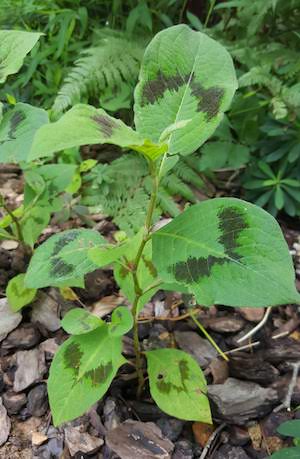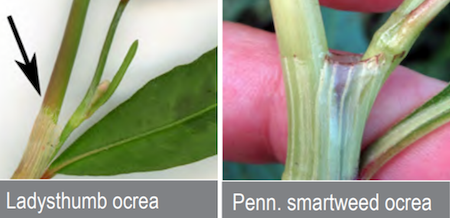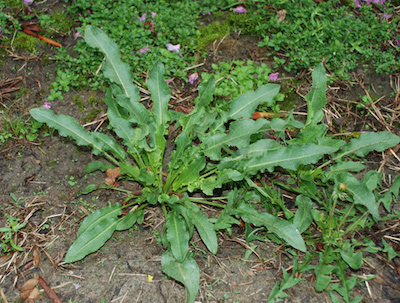The Family Polygonum: Smartweeds and Knotweeds
Pesky Annual Weeds and Troublesome Perennials

Pennsylvania Smartweed (Polygonum pensylvanicum)
Have you ever seen pink, green or white flowers on a broadleaf grass-like plant and wonder if it is a weed or a plant to keep? I have. In fact, I so admired one that I planted it in my ornamental bed before I knew what it was. It settled in nicely, found its niche and emerged every year. Visitors to my yard stopped in their tracks and always asked what it was. With its beautiful oval medium green leaves with a red thumb mark, it grew and thrived in my sunny to partly shady yard. Then it took over. My love affair with this perennial hit the reality that my beautiful plant needed annual maintenance to keep its rambunctious joyfulness in bounds.
So, what is this subtly beguiling chameleon that entices the gardener but is a widely spreading native? And what are its garden cousins?
Smartweeds and Knotweeds are two categories of members of the botanic family Polygonaceae, the Buckwheat family, and are in the genus Polygonum sp. or Persicaria sp. This consists of annual and perennial plants. All members of this family have similar key characteristics. Simple alternating leaves with one leaf per swollen node — a thicker section on the stem at each leaf joint. The leaf base forms a kind of membranous sheath (an ocrea) where the leaf joins the stem. Gardeners can use the ocrea to distinguish among members of this family. Most members of this family have either rhizomes or fibrous roots.

Virginia Knotweed (Persicaria virginiana, ‘Painter’s Pallett’)
Other members of this family look similar and might confuse the gardener. Two common annuals have leaves with red thumbprint markings. One, the invasive, non-native Spotted Lady’s Thumb (Persicaria maculosa, aka Polygonum Persicaria), is a weed that can naturalize. Its long slender sword-shaped leaves appear pointed at both the base and tip. The second, the annual, Pennsylvania Smartweed (Polygonum pensylvanicum), has pink flowers appearing in tight terminal clusters. Its alternative leaves are lanceolate (sword-like) or oblong with a rounded base and pointed tips, and the leaves appear on short stalks. The gardener can distinguish between these two by looking at the ocrea, the lower part of the leaf which encircles the node (the place where the stem and the leaf join). The ocrea of the Lady’s Thumb has a hairy top while the Pennsylvania Smartweed has a smooth top. While their pink flowers are pretty, it is best to remove these weeds quickly, so they do not settle into the garden or turf.

Comparison of the Ocrea of Ladysthumb Smartweed and Pennsylvania Smartweed

Curly Dock (Rumex crispus)
Many other Smartweeds grow in or near ponds, lakes and other wet places including Waterpepper or Swamp Smartweed (Persicaria hydropiperoides, aka Polygonum hydropiperoides); Longroot Smartweed (Persicaria amphibia, aka Polygonum amphibium); Pink Smartweed (Persicaria bicornis); and the non-native Marshpepper Smartweed (Persicaria hydropiper, aka Polygonum hydropiper).
Virginia Tech reports that pre-emergent herbicides are effective if applied in the late fall, winter or early spring before the weed seeds germinate. There are a few post-emergent herbicides containing dicamba that can control these plants. Before using any herbicide, please do your research, read and follow herbicide labels. Some annual Smartweeds are easily controlled by pulling the weeds out after misting the soil lightly. For the perennial Knotweeds, persistence is needed to mechanically remove the crown and roots in established plants — it is best to pull them when they emerge.
This article might give the impression that most members of the Polygonum family have little value. So, I will mention that one of my favorite summer foods is rhubarb (Rheum sp), a perennial member of the Buckwheat family. The gardener can harvest and eat (raw or cooked) the reddish green leaf stalk (petiole) but avoid ingesting the large leaves and roots which contain the toxicant oxalic acid.
Resources
• 2020 Pest Management Guide: Home Gardens and Animals, Chapter 4, Home Ornamentals: Weed
Management in Ornamental Beds, Tables 4-11 and 4-16, Virginia Cooperative Extension,
Publication 456-018
• Weed Identification, College of Agricultural and Life Sciences, Virginia Tech
• Smartweed, Polygonum spp., Texas A&M AgriLife Extension
• Persicaria virginiana, Missouri Botanical Garden
• Pennsylvania Smartweed (Polygonum pensylvanicum), Michigan State University
• Smartweed or Knotweed, Polygonum sp., Brandeis University
• Increasing Your Knowledge About Smartweeds (Polygonaceae Family), University of Illinois
• Identification of Common Wisconsin Weeds, University of Wisconsin